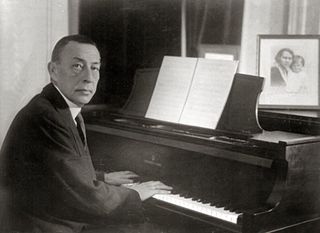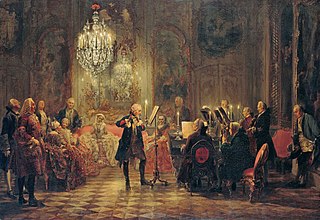
The cello ( CHEL-oh; plural celli or cellos) or violoncello ( VY-ə-lən-CHEL-oh; Italian pronunciation: [vjolonˈtʃɛllo]) is a bowed (sometimes plucked and occasionally hit) string instrument of the violin family. Its four strings are usually tuned in perfect fifths: from low to high, C2, G2, D3 and A3. The viola's four strings are each an octave higher. Music for the cello is generally written in the bass clef, with tenor clef and treble clef used for higher-range passages.

Music is the art of arranging sounds in time through the elements of melody, harmony, rhythm, and timbre. It is one of the universal cultural aspects of all human societies. General definitions of music include common elements such as pitch, rhythm, dynamics, and the sonic qualities of timbre and texture. Different styles or types of music may emphasize, de-emphasize or omit some of these elements. Music is performed with a vast range of instruments and vocal techniques ranging from singing to rapping; there are solely instrumental pieces, solely vocal pieces and pieces that combine singing and instruments. The word derives from Greek μουσική.

The piano is an acoustic, keyboard and stringed musical instrument in which the strings are struck by wooden hammers that are coated with a softer material. It is played using a keyboard, which is a row of keys that the performer presses down or strikes with the fingers and thumbs of both hands to cause the hammers to strike the strings. It was invented in Italy by Bartolomeo Cristofori around the year 1700.

A pianist is an individual musician who plays the piano. Since most forms of Western music can make use of the piano, pianists have a wide repertoire and a wide variety of styles to choose from, among them traditional classical music, jazz, blues, and all sorts of popular music, including rock and roll. Most pianists can, to an extent, easily play other keyboard-related instruments such as the synthesizer, harpsichord, celesta, and the organ.

The viola ( vee-OH-lə, alsovy-OH-lə, Italian: [ˈvjɔːla, viˈɔːla]) is a string instrument that is bowed, plucked, or played with varying techniques. Slightly larger than a violin, it has a lower and deeper sound. Since the 18th century, it has been the middle or alto voice of the violin family, between the violin (which is tuned a perfect fifth above) and the cello (which is tuned an octave below). The strings from low to high are typically tuned to C3, G3, D4, and A4.

Chamber music is a form of classical music that is composed for a small group of instruments—traditionally a group that could fit in a palace chamber or a large room. Most broadly, it includes any art music that is performed by a small number of performers, with one performer to a part. However, by convention, it usually does not include solo instrument performances.
Sheet music is a handwritten or printed form of musical notation that uses musical symbols to indicate the pitches, rhythms, or chords of a song or instrumental musical piece. Like its analogs – printed books or pamphlets in English, Arabic, or other languages – the medium of sheet music typically is paper. Although the access to musical notation since the 1980s has included the presentation of musical notation on computer screens and the development of scorewriter computer programs that can notate a song or piece electronically, and, in some cases, "play back" the notated music using a synthesizer or virtual instruments.
A piano trio is a group of piano and two other instruments, usually a violin and a cello, or a piece of music written for such a group. It is one of the most common forms found in classical chamber music. The term can also refer to a group of musicians who regularly play this repertoire together; for a number of well-known piano trios, see below.

A composer is a person who writes music, especially classical music in any form, including vocal music, instrumental music, electronic music, and music which combines multiple forms. A composer may create music in any music genre, including, for example, classical music, musical theatre, blues, folk music, jazz, and popular music. Composers often express their works in a written musical score using musical notation.

A piano concerto is a type of concerto, a solo composition in the classical music genre which is composed for a piano player, which is typically accompanied by an orchestra or other large ensemble. Piano concertos are typically virtuoso showpieces which require an advanced level of technique on the instrument. These concertos are typically written out in music notation, including sheet music for the pianist, orchestra parts for the orchestra members, and a full score for the conductor, who leads the orchestra in the accompaniment of the soloist.

The bass clarinet is a musical instrument of the clarinet family. Like the more common soprano B♭ clarinet, it is usually pitched in B♭, but it plays notes an octave below the soprano B♭ clarinet. Bass clarinets in other keys, notably C and A, also exist, but are very rare. Bass clarinets regularly perform in orchestras, wind ensembles/concert bands, occasionally in marching bands, and play an occasional solo role in contemporary music and jazz in particular.

A rhythm section is a group of musicians within a music ensemble or band that provides the underlying rhythm, harmony and pulse of the accompaniment, providing a rhythmic and harmonic reference and "beat" for the rest of the band. The rhythm section is often contrasted with the roles of other musicians in the band, such as the lead guitarist or lead vocals whose primary job is to carry the melody.

Jazz piano is a collective term for the techniques pianists use when playing jazz. The piano has been an integral part of the jazz idiom since its inception, in both solo and ensemble settings. Its role is multifaceted due largely to the instrument's combined melodic and harmonic capabilities. For this reason it is an important tool of jazz musicians and composers for teaching and learning jazz theory and set arrangement, regardless of their main instrument. By extension the phrase 'jazz piano' can refer to similar techniques on any keyboard instrument.

The E-flat clarinet is a member of the clarinet family, smaller than the more common B♭ clarinet and pitched a perfect fourth higher. It is typically considered the sopranino or piccolo member of the clarinet family and is a transposing instrument in E♭ with a sounding pitch a minor third higher than written. In Italian it is sometimes referred to as a terzino and is generally listed in B♭-based scores as terzino in Mi♭. The E-flat clarinet has a total length of about 49 cm.
The modern form of the piano, which emerged in the late 19th century, is a very different instrument from the pianos for which earlier classical piano literature was originally composed. The modern piano has a heavy metal frame, thick strings made of top-grade steel, and a sturdy action with a substantial touch weight. These changes have created a piano with a powerful tone that carries well in large halls, and which produces notes with a very long sustain time. The contrast with earlier instruments, particularly those of the 18th century is very noticeable. These changes have given rise to interpretive questions and controversies about performing earlier literature on modern pianos, particularly since recent decades have seen the revival of historical instruments for concert use.

The euphonium repertoire consists of solo literature and parts in band or, less commonly, orchestral music written for the euphonium. Since its invention in 1843, the euphonium has always had an important role in ensembles, but solo literature was slow to appear, consisting of only a handful of lighter solos until the 1960s. Since then, however, the breadth and depth of the solo euphonium repertoire has increased dramatically.

Piano four hands is a type of piano duet involving two players playing the same piano simultaneously. A duet with the players playing separate instruments is generally referred to as a piano duo.

According to the Grove Dictionary of Music and Musicians, there are two kinds of piano duet: "those for two players at one instrument, and those in which each of the two pianists has an instrument to themself." In American usage the former is often referred to as "piano four hands". Grove notes that the one-piano duet has the larger repertory, but has come to be regarded as a modest, domestic form of music-making by comparison with "the more glamorous two-piano duet". The latter is more often referred to as a piano duo.

An organist is a musician who plays any type of organ. An organist may play solo organ works, play with an ensemble or orchestra, or accompany one or more singers or instrumental soloists. In addition, an organist may accompany congregational hymn-singing and play liturgical music.
The Sonata in A major for Violin and Piano by César Franck is one of his best-known compositions, and is considered one of the finest sonatas for violin and piano ever written. It is an amalgam of his rich native harmonic language with the Classical traditions he valued highly, held together in a cyclic framework.















